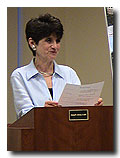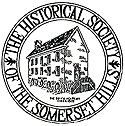The Historical Society of the Somerset Hills
Historic Preservation Awards
Awards for noteworthy historic preservation projects in the Somerset Hills are presented by the Historical Society of the Somerset Hills to recognize local projects preserving historic buildings and enhancing neighborhood character. Presentation of the awards are also accompanied by a narrated slide program about the projects.
Over the years awards have been given to a wide variety of realistic and practical preservation projects that have successfully preserved and adapted familiar landmarks throughout the five communities. Noteworthy projects that substantially enhance the Somerset Hills communities are being recognized. “It is gratifying to formally acknowledge a group of projects that demonstrate some of the benefits achieved by preserving our familiar and beloved buildings and landmarks,” said Marcella Miccolis, Chairman of the Historical Society.To learn more about the nomination process
2008 Historic Preservation Awards
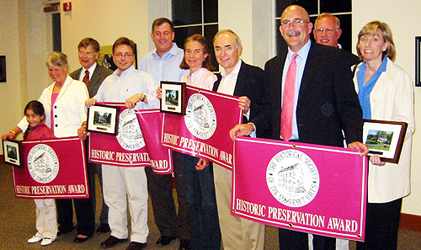
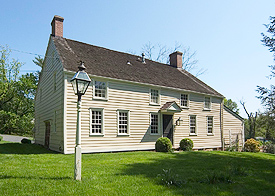
Liberty Corner
Category: Preservation
An 18th-century house at 376 Mount Airy Road in Basking Ridge represents a significant restoration effort over many years by owner Craig Johnston. The asymmetry of the original south facing front façade of this vernacular dwelling reflect cultural influences and traditional building practices of the area’s early settlers. Although construction dates for most 18th century houses are difficult to document, the east half of the Johnston house is believed to have been built around 1720. The west half of the house was probably added later in the 18th century.
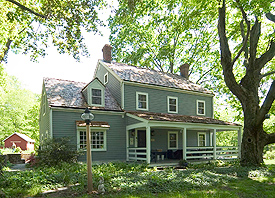
Liberty Corner
Category: Preservation
Showing influences from Georgian architecture, the dominant style in the American colonies during 18th century that continued to be popular into the early 19th century is the house at 415 Mountain Road, Liberty Corner. The house began around 1830 as a side-hall (or “half house”) version of the formal center hall Georgian plan. According to homeowners Carolyn and William Knox, the house grew in the late 19th century with the addition of a wing that was moved to the property from a nearby site where it had originally served as a goat barn. In more recent years, the owners have added wings discreetly located at the rear of the house. Outbuildings on the property include one of the few surviving corncribs in Bernards Township, as well as a barn that has been moved twice in its long history.
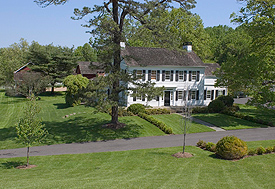
Far Hills
Category: Preservation
Based upon the Greek Revival details evident in its front door surround, Applewood Farm, Far Hills, dates to the early decades of the 19th century, when archeological investigations stimulated public interest in Greece and influenced American architecture. The small east wing is reminiscent of an early East Jersey Cottage, a traditional house type common in the vicinity during the 18th century. Behind the south-facing house is a small English barn that is distinguished by the very fine workmanship displayed in its joinery and currently provides recreation space for the family of Thomas and Bonnie Mahala.
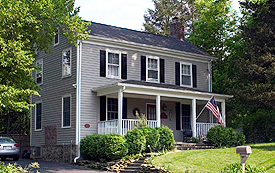
Basking Ridge
Category: Preservation
Also dating to around 1830 is the small center hall Georgian house at 107 North Maple Avenue in Basking Ridge, currently owned by Tim Reilly and Bruce Lasko. Visible at the north end of the house is the exposed lower portion of the stone chimney, a feature characteristic to 18th and early 19th century houses in the region. The front porch was likely added during the second half of the 19th century, when full-width porches became popular. Typical of 19th century expansion, a two-story wing was added to the rear of the house.
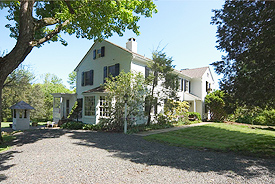
Liberty Corner
Category: Preservation
The early house at 300 Somerville Road, Liberty Corner, owned by Stephen and Allison Neumann, is another example of a vernacular house that grew over time. The close proximity of the house and adjacent barn to the road would have been typical during the 18th century and 19th centuries.
2007 Historic Preservation Awards

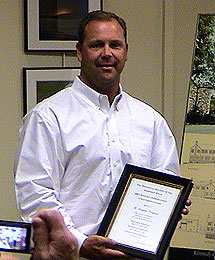
Portfolio Manager, Hampshire Legacy Group
2007 Achievement Award
2007 Winner – The Hampshire Properties of Morristown
In the category of achievement over time, an award category introduced in 2006, this year the Historical Society is delighted to recognize the local preservation efforts by The Hampshire Properties, a subsidiary of Hampshire Real Estate Companies.
During the last several years, the company has been responsible for the sensitive rehabilitation of two prominent landmark buildings in Bernardsville and the construction of a compatible new building in Basking Ridge.
The former Bernardsville Library on Morristown Road was sympathetically rehabilitated and converted to commercial space, now called “The Old Library.”
The Station Bar and Grill on Minebrook Road in Bernardsville, originally built as the Claremont Hotel, was updated with a new interior and refreshed exterior, and was reopened as the Station Pub and Grub.
In Basking Ridge, the downtown has been revitalized by the new Base Camp Outfitter /Apogee mixed-use building on South Finley Avenue.
The company also recently acquired the Bernards Inn and Jeroloman’s General Store, both in Bernardsville, with plans to continue to preserve both of these noteworthy buildings.
2007 Historic Preservation Awards
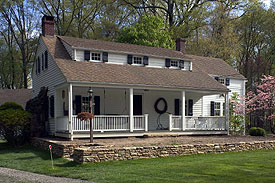
2007 Historic Preservation Awards
Basking Ridge
Category: Preservation
249 Madisonville Road, Basking Ridge, NJ
Down a long driveway at 249 Madisonville Road in Bernards Township is an early 19th century frame house that was rescued by its current owners Gary and Anne marie Frendak, from a severely deteriorated condition. It is being recognized as an impressive preservation project achieved through careful repairs and ongoing maintenance, one of a series of charming houses in the historic Madisonville hamlet that have been recognized for preservation work in recent years.
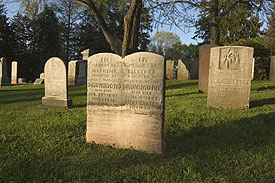
Basking Ridge
Category: Preservation
Historic Churchyard Headstones –
The Presbyterian Church of Basking Ridge
1 East Oak Street, Basking Ridge, NJ
This year for the first time, THSSH is recognizing efforts to preserve a site, structure or object. The Presbyterian Church of Basking Ridge and the Cemetery Heritage Committee funded a major multi-year project to repair, reset, and protect an important group of early headstones in its adjacent church yard, which contains some of the earliest graves in the Somerset Hills and is listed as a contributing resource to the National Register-listed church.
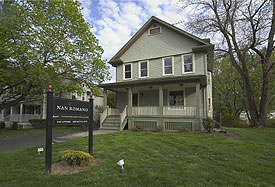
Bedminster
Category: Adaptive Use
In the category of adaptive use, three businesses were selected that show the positive impacts of finding new uses for old buildings.
Nan Romano Fine Apparel
432 Main Street, Bedminster, NJ
On Main Street in Bedminster, the Nan Romano building owned by Charles and Nan Romano, is a fine example of a modestly scaled house that has been sensitively converted to a women’s apparel shop, which is compatible with the historic village streetscape.
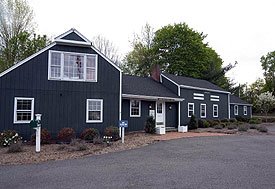
Basking Ridge
Category: Adaptive Use
Sandra John Interiors –
374 North Maple Ave, Basking Ridge, NJ
In Basking Ridge, the Sandra John building at the corner of North Maple Avenue and Route 202 had been slated for demolition until new owners, Sandra and John McDonald, arrived with a fresh approach. Originally a 19th century wagon house, the building had previously been adapted for commercial use, but by the early 21st century its viability was in question. However, the historic character of the old building was a perfect fit for the Sandra John Interior design firm, which preserved interior and exterior features of the building.
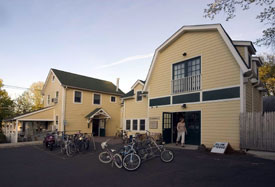
Basking Ridge
Category: Adaptive Use
Liberty Cycle –
107 South Maple Avenue, Basking Ridge, NJ
On South Maple Avenue in Basking Ridge, Liberty Cycle has occupied the ground floor of a 19th century dwelling for several years, while the shop owners Greg and Ingrid Cordasco lived upstairs. Last year, the owners expanded both the shop and upstairs living quarters by means of an appealing barn-like addition that is compatible with the historic village business district.
The bicycle shop gained a new repair shop and a growing family achieved its goal to continue living in this mixed-use building, resulting in a project that enriches the neighborhood.
2006 Historic Preservation Awards
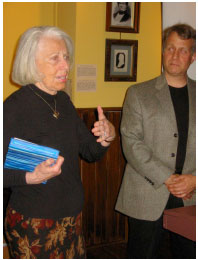
2006 Winner – Bea Dreesen, Bernardsville, New Jersey
In 2006, the Historical Society introduced an award to recognize personal effort and achievement over time. Bea Dreesen of Bernardsville, a past Chairman of the Historical Society and a long time passionate advocate of historic preservation, was selected to be the first recipient of this award in recognition of her many years of effort on behalf of historic preservation in the Somerset Hills.
Mrs. Dreesen is pictured with Dan Lincoln, President of the Historical Society.
2006 Historic Preservation Awards
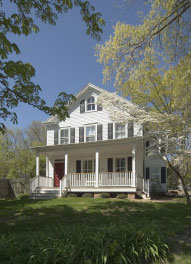
Basking Ridge
Category: Preservation
82 North Finley Avenue, Basking Ridge, NJ
In the category of preservation, three Basking Ridge projects were selected to show the important impacts that modestly scaled projects can have. At 82 North Finley Avenue, this private residence with it’s new owners carefully replicated the character-defining front porch of this mid-19th century vernacular Italianate house, even including new brick piers.
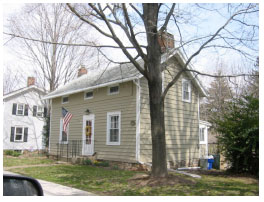
Basking Ridge
Category: Preservation
130 South Maple Avenue, Basking Ridge, NJ
This private residence at 130 South Maple Avenue removed old asphalt shingles to reveal original clapboard on this c. 1830 East Jersey Cottage, which was able to be repaired and preserved, an effort that contributes significantly to the streetscape.
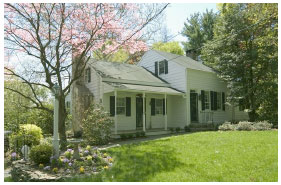
Basking Ridge
Category: Preservation
201 Madisonville Road, Basking Ridge, NJ
At 201 Madisonville Road, Basking Ridge, this private residence and it’s long time owners continued to preserve their c. 1820 home, which includes an East Jersey Cottage section and another section that may have originally been a shop or store in the small hamlet of Madisonville.
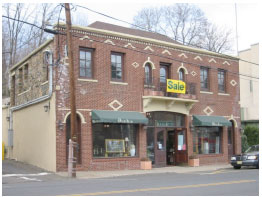
Bernardsville
Category: Adaptive Reuse
Door Decor –
67 Minebrook Road, Bernardsville, NJ
Downtown Bernardsville benefited from work done by the owners of Door Décor on their building at 67 Minebrook Road. Previously used as an auto showroom, and perhaps originally constructed to build and repair horse-drawn carriages, the building was sensitively adapted to become a showcase for an interior-decorating store. The distinctive polychrome brick details and early stone construction were retained, successfully preserving this familiar Bernardsville landmark.
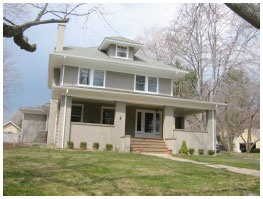
Bernardsville
Category: Preservation and Compatible New Addition
26 Olcott Avenue, Bernardsville, NJ
The Arts and Crafts inspired house at this private residence at 26 Olcott Avenue in Bernardsville might be less ornate in style than some of the other houses on the street, but its owners recognized the strength in its simplicity, a hallmark of Arts and Crafts style. Not only did they undertake a careful project to preserve and maintain the exterior, they also added an addition, discreetly located at the rear, which is compatible to the architectural style and unobtrusive to the historic streetscape.
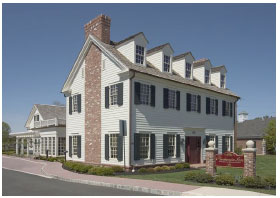
Bedminster
Category: Compatible New Construction
The Pluckemin Inn –
359 Route 202/206, Bedminster, NJ
Justifiably proud of their new addition to the Pluckemin Historic District, the Bedminster Historic Commission nominated the Pluckemin Inn on Rt. 202/206 in the category of compatible new construction. The owners of the Inn worked to make sure their new building would have an aura of an early tavern that would add to the streetscape. The architect designed a building reminiscent of a colonial tavern style, and placed the building close to the road, in keeping with the historic buildings in the district.
2005 Historic Preservation Awards
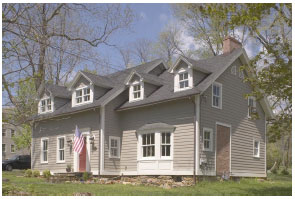
Basking Ridge
Category: Rehabilitation
189 West Oak Street, Basking Ridge, NJ
This private residence, sometimes referred to as “The Old Homestead,” the house at 189 West Oak Street is an excellent example of local vernacular architecture. Two deeds dated November 27, 1807 recorded the sale of the house and premises from William Crane and John McEowen to Aaron Hand. The historic postcard illustrates the historic home as it appeared in the late 19th century. The property was unoccupied for a number of years and had fallen into a totally deteriorated condition when it was sold in 2002. Now owned by Keith and Jennifer Style, the house is being recognized as an impressive rehabilitation project that has respected the layered history and preserved important aspects of this old familiar landmark while adapting it for use by a young 21st century family.
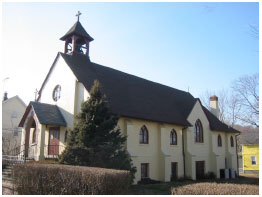
Bernardsville
Category: Preservation
Chapel of the Sacred Heart – Bernards Avenue and Maple Street, Bernardsville, NJ
The Sacred Heart Chapel is being recognized for the continuing and careful maintenance to preserve the historic appearance of this simple Gothic Revival building. The circa 1911 chapel, which belongs to the parish of Our Lady of Perpetual Help in Bernardsville, was built with labor donated by members of the Italian immigrant community that developed in the Bernards Avenue neighborhood for workers on the grand estates of the Mountain Colony. Home to the Bernardsville Senior Center – (908) 766-7434
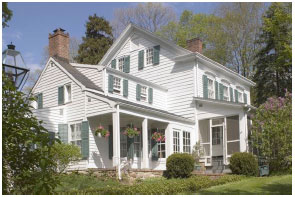
Basking Ridge
Category: Preservation
The Coffee House – Madisonville Road, Basking Ridge, NJ
This well-kept white clapboard home is a fine example of careful and deliberate preservation efforts that have been ongoing for many years. The Coffee House has been in the Turner family since Clara Dayton, acquired the home in 1905 and is a functioning private residence today. The house is a familiar local landmark, and it is believed that Continental Army soldiers, perhaps including General George Washington, stopped in for coffee, thus the name “Coffee House.”
The name “Madisonville Coffee House” appears on a map dating to 1818. At that time it was being operated as a tavern. The house, which is listed on the National Register of Historic Places, was built in several states beginning in about 1806. The larger Italianate section of the house dates to the second half of the 19th century.
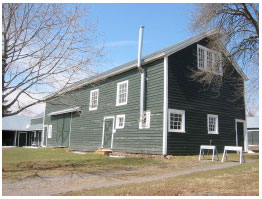
Bedminster
Category: Adaptive Use
Upper Raritan Watershed Association’s Fairview Farm
2121 Larger Cross Road, Bedminster, NJ
The circa 1814 English-style barn at Upper Raritan Watershed Association’s Fairview Farm is being recognized for adaptive use of the building for programming space for the conservation organization, which effectively preserves an important historic resource by giving it a new use.
In 2002 Preservation New Jersey placed historic barns on its annual endangered list, due to the rapid disappearance of these important legacies of our agricultural heritage. In a happy convergence of open space conservation and historic preservation, the efforts of URWA assure that this early barn will continue to survive.
The historic barn is part of a complex of early agricultural outbuildings, shown in the photograph. From left to right in the photograph are the corncrib, the English barn, the stable, the piggery, and a wagon shed.
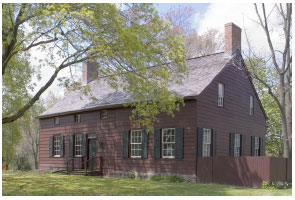
Bedminster
Category: Restoration
The Jacobus Vanderveer House –
Route 206, Bedminster, NJ
The Jacobus Vanderveer House is being recognized for the meticulous restoration of the exterior of this National Register site. The house is significant for its role in the Revolutionary War and is the only known extant building associated with the Pluckemin encampment of 1778-79, which is considered to be the first installation in America to train officers in engineering and artillery. The house is a fine example of an 18th-century Dutch-framed building with an early 19th century Federal-style addition. As part of the restoration, additions and alterations from the late-19th and early-20th centuries were removed to return the building to its circa 1813 appearance. The carefully researched project is an inspiring example of a successful public-private historic preservation collaboration, involving Bedminster Township and Friends of the Jacobus Vanderveer House, with funding from Somerset County and New Jersey Historic Trust grants.
For additional information, visit www.jvanderveerhouse.com
2004 Historic Preservation Awards
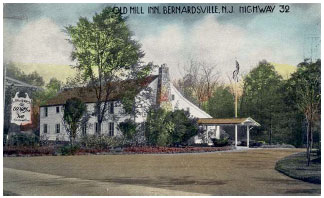
Basking Ridge
Category: Preservation
Grain House Restaurant –
225 US Highway 202 , Basking Ridge, NJ
The Grain House Restaurant was originally constructed by Samuel Lewis in 1769 as a grain storage barn next to a gristmill across the road. (The current stone mill was constructed in 1843 on the site of the earlier mill.) The barn reportedly was used during the Revolutionary War to store grain during the Jockey Hollow encampment.
In 1930, the building was moved by William Childs to its current location and converted into a restaurant. Nearly 75 years later, the exterior of the building continues to retain its historic character through careful and regular attention to maintenance and repairs.
For additional information visit http://www.oldemillinn.com/docs/grainhouse_history.pdf
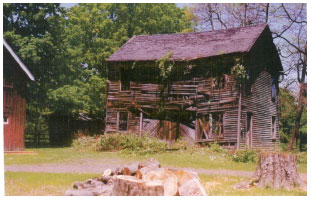
Basking Ridge
Categories: Restoration and Adaptive Use
Carriage House
Madisonville Road, Basking Ridge, NJ
The Carriage House at Coffee House Corner was built in 1871 and by the late 20th Century was in a very deteriorated condition when Bob Cramer began restoring the exterior of the building and converting it into a home. The Carriage House was originally part of the “Coffee House” property, though it was built after the period that the “Coffee House” was conducted as a crossroads tavern.
This “before” photograph of the building shows clearly just how impressive this seven-year long restoration project is.
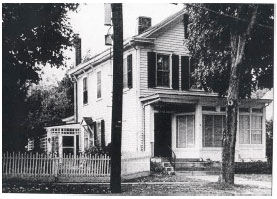
Basking Ridge
Category: Compatible New Addition
Wealth Strategies Building –
11 South Finley Ave, Basking Ridge, NJ
The Wealth Strategies Building (also known as the Schuerman Building) was constructed in 1882. It was the lifetime home of William Schuerman, who became township postmaster, and served as the post office from 1919 to 1952.
The large addition at the rear of the building, facing the parking lot, was designed to be compatible to the original building and to be nearly invisible from the street view, thus preserving the familiar village streetscape. Badly needed commercial space was created while retaining the important character and significant details of the original building.
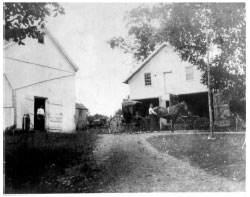
Liberty Corner
Category: Preservation
English Farm –
3625 Valley Road, Basking Ridge, NJ
The English Farm was probably established before 1750 by Jacob Castner and Castner descendents – which include the English family – have continuously owned and farmed the property ever since. The farm is within the Liberty Corner Historic District, and was the site of Rochambeau’s encampment in 1781/2.
The farmstead is important for its architectural integrity, including the main farmhouse, a large 19th century barn complex, as well as its extensive farm fields and pastureland, which further enhance its appearance and historical significance. The farm vistas on both sides of Valley Road are a familiar landscape and help to define the character of Liberty Corner. The English Farm is one of the last active farms in Bernards Township, and is an important reminder that the township was originally almost entirely agrarian.
The English Farm continues today as one of the few remaining functioning farms in the area.
Additional Information:
History of the English Farm – Click Here
Heritage Commission Presentation – Click Here
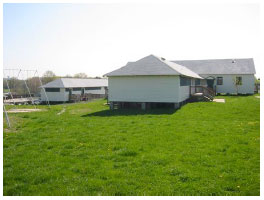
Liberty Corner
Category: Preservation
Fellowship Deaconry
3575 Valley Road, Liberty Corner, NJ
The Summer Camp Buildings at the Fellowship Deaconry were constructed during World War I for use as army barracks. They were purchased by the Fellowship Deaconry and moved to Liberty Corner in 19xx, where they were used as dormitories, dining facilities, and an activity center for the summer camp. Although no longer an overnight camp, the summer camp program has continued.
Recently, the buildings were moved again, to a new location on the Fellowship Deaconry property, where they continue to be used by hundreds of day campers each year. Although these utilitarian buildings are plain in appearance they are important reminders of this country’s wartime experience. Moving and reusing buildings used to be a very commonplace occurrence, and the Fellowship Deaconry has once again successfully demonstrated moving as a useful method of preservation.





